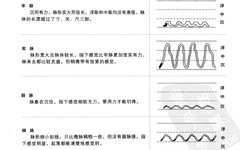 TCM Case Studies / Medical Discussions / Reference Articles for Learning Clinical TCM
TCM Case Studies / Medical Discussions / Reference Articles for Learning Clinical TCM Introduction:Pulses can be floating or sinking, and diseases can be cold or hot, interior or exterior; today we learn about the Chen Mai (Deep Pulse).
Introduction:Pulses can be floating or sinking, and diseases can be cold or hot, interior or exterior; today we learn about the Chen Mai (Deep Pulse).
The Chen Mai and its easily confused pulses
Chen Mai is like the heavy and turbid earth energy, constantly sinking. To feel the pulse, one must press hard to reach the sinews and bones to sense it. There are five pulses that are similar to Chen Mai, namely Fu Mai (Floating Pulse), Lao Mai (Firm Pulse), Shi Mai (Full Pulse), Ruo Mai (Weak Pulse), and Xi Mai (Thin Pulse). The Fu Mai is deeper than Chen Mai, requiring strong pressure on the sinews and bones to vaguely feel the pulse; the Lao Mai is deep and strong, with a large and taut pulse body that is not visible when floating; the Shi Mai is even more solid and powerful, with a very strong pulsation; the Ruo Mai is deep yet weak, soft and small like cotton fluff; and the Xi Mai is even smaller, as thin as spider silk.
Comparison chart of Chen Mai and similar pulses
Fu Mai, Lao Mai, Shi Mai, Ruo Mai, and Xi Mai are all similar to Chen Mai, sharing the commonality of being obtainable when pressed down. However, they each have distinct characteristics, and thus should be differentiated. Note:Please follow medical advice for specific treatment and medication!This article is excerpted from Li Shizhen’s Teachings on Pulse Diagnosis, Wang Jiran, Zhang Li interpretation, Chongqing Publishing House, 2010.2. This public account is used solely for academic exchange; if there is any infringement, please contact for deletion, and please indicate the source when reprinting.You may also like, click to read the original text:What are the differences between Fu Mai and its similar pulses, and how to distinguish them?What does a pulse indicating joy look like? How to recognize it?//////////
Note:Please follow medical advice for specific treatment and medication!This article is excerpted from Li Shizhen’s Teachings on Pulse Diagnosis, Wang Jiran, Zhang Li interpretation, Chongqing Publishing House, 2010.2. This public account is used solely for academic exchange; if there is any infringement, please contact for deletion, and please indicate the source when reprinting.You may also like, click to read the original text:What are the differences between Fu Mai and its similar pulses, and how to distinguish them?What does a pulse indicating joy look like? How to recognize it?////////// [ Read Previous Highlights ]
[ Read Previous Highlights ]


